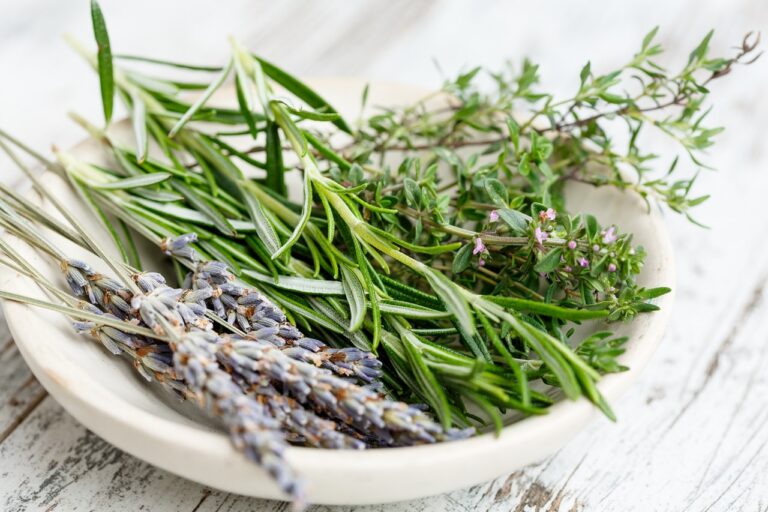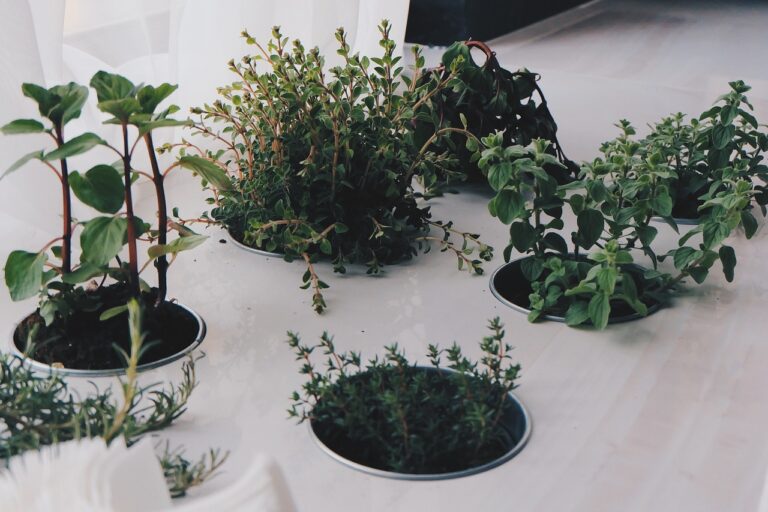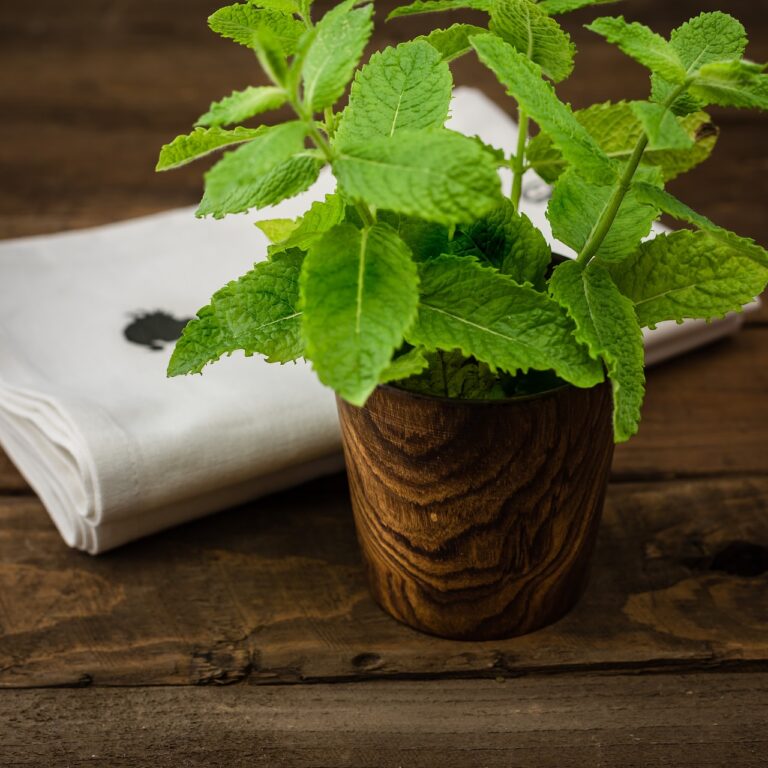An In-depth Look at Different Rosemary Species
From the mesmerizing Rosemarinus Arp, thriving in chilly climates and boasting delicate light blue flowers, to the sprawling elegance of Rosemarinus ‘Huntingtons Carpet’, with its remarkable trailing growth and light blue blossoms, each variety offers unique characteristics. Culinary enthusiasts savor the robust flavor of Rosemarinus ‘Tuscan Blue’, a favorite for its fragrance and ability to attract pollinators. The intricate details of Rosemarinus Foresteri and Rosemarinus Irene further add to the alluring allure of these diverse rosemary species. Each species holds its own botanical charm, waiting to be explored further.
Rosemarinus Arp: Cold-Hardy Upright Variety
Rosemarinus Arp, a sturdy and cold-resistant upright rosemary variety, thrives in temperatures as low as -10°F. This variety of rosemary grows in an upright manner, reaching heights of up to 4 feet tall. Its delicate light blue flowers not only add to its aesthetic appeal but also attract pollinators to the garden. The lemon scent emanating from the foliage of Rosemarinus Arp adds a invigorating aspect to the garden environment.
In addition to its visual and olfactory charms, Rosemarinus Arp is known for its resilience, making it a popular choice among gardeners in colder climates. Its ability to withstand harsh conditions and low temperatures (suitable for zones 7-10) makes it a valuable addition to any garden. The silvery-green leaves of Rosemarinus Arp not only contribute to its colorful appearance but also emit a pleasant aroma that is distinctive to the rosemary species.
Gardeners appreciate Rosemarinus Arp not only for its hardiness but also for its versatility. Not only does it serve as an ornamental plant, but it also finds its way into various culinary dishes, enhancing the flavor profile with its unique lemony essence. Overall, Rosemarinus Arp stands out as a cold-resistant, upright rosemary variety that combines aesthetic beauty, resilience, and functionality.
Rosemarinus ‘Huntingtons Carpet’: Trailing Spread
I have observed that Rosemarinus ‘Huntingtons Carpet’ exhibits remarkable trailing growth characteristics, making it an excellent choice for cascading down walls or in hanging baskets. This variety thrives in full sun and well-draining soil, requiring minimal water once established. ‘Huntingtons Carpet’ not only adds a touch of beauty with its light blue flowers but also imparts a delightful fragrance to the landscape.
Trailing Growth Characteristics
With a fast-spreading habit and delicate light blue flowers, the trailing rosemary variety ‘Huntingtons Carpet‘ showcases a lush ground cover that can reach a height of 18 inches and spread out 4-6 feet wide. This creeping rosemary is ideal for cascading down walls or rockeries, adding a touch of beauty to various landscapes. ‘Huntingtons Carpet’ is known for its multiple bloom cycles throughout the growing season, ensuring a continuous display of its charming blue flowers. Being low-maintenance and suitable for zones 8-11, this trailing rosemary is a great option for those seeking an easy-to-care-for yet visually appealing plant. Whether used as a ground cover or allowed to cascade down slopes, this variety adds a lovely touch to any garden setting.
Ideal Growing Conditions
Trailing rosemary varieties like ‘Huntingtons Carpet‘ flourish in specific growing conditions that promote their cascading spread and vibrant blooms. To guarantee ideal growth, plant this fast-spreading rosemary in full sun within zones 8-11. It prefers well-draining soil to prevent waterlogging, which can lead to root rot. ‘Huntingtons Carpet’ is prized for its cascading growth habit, reaching a height of around 18 inches, making it ideal for ground cover or hanging baskets. The light blue flowers it produces not only add visual appeal but also emit a fragrant aroma, enhancing the overall garden experience. By meeting these ideal growing conditions, you can enjoy the beauty and benefits of this charming trailing rosemary variety.
Landscape Design Applications
Rosemarinus ‘Huntingtons Carpet’ showcases a rapid trailing spread, making it an excellent choice for ground cover or cascading applications in landscape designs. This variety of Rosemarinus, known for its light blue flowers, can reach a height of 18 inches and spread 4-6 feet. ‘Huntingtons Carpet’ is favored for its ability to cover large areas swiftly, adding a burst of color and fragrance to garden borders or rockeries. Its cascading nature allows for beautiful displays when planted on slopes or allowed to spill over walls. Suitable for zones 8-11, this trailing rosemary thrives in full sun and well-draining soil, requiring minimal upkeep once established. In landscape design, Rosemarinus ‘Huntingtons Carpet’ offers versatility and aesthetic appeal.
Rosemarinus ‘Salem’: Fragrant Upright Rosemary
I’ll start by highlighting the fragrant characteristics of Rosemarinus ‘Salem,’ a variety prized for its upright growth habit. The mounding form of ‘Salem’ makes it an excellent choice for creating hedges or compact shrub borders. With its medium blue flowers and aromatic foliage, this cultivar is favored for both culinary and ornamental purposes.
Fragrant ‘Salem’ Characteristics
With its mounding growth habit and medium blue flowers, ‘Salem’ Rosemary (Rosemarinus ‘Salem’) stands out as a versatile herb suitable for both culinary and ornamental purposes. Here are some key characteristics of this fragrant upright rosemary:
- ‘Salem’ Rosemary is a mounding variety that can reach heights of 3-4 feet, making it ideal for creating hedges.
- The plant features medium blue flowers that add a vibrant touch to garden landscapes.
- Known for its drought-tolerant nature, ‘Salem’ Rosemary thrives in full sun and requires well-draining soil.
- With its compact growth habit, this herb is easy to maintain and benefits from pruning after flowering to promote new growth and maintain its shape.
Growth Habits of ‘Salem’
Demonstrating a vigorous growth pattern, the ‘Salem’ rosemary variety exhibits a mounding habit that can reach heights between 3 to 4 feet, making it an excellent choice for creating structured hedges or borders. Its upright form adds a vertical element to garden landscapes, while the fragrant foliage and medium blue flowers provide aesthetic appeal. ‘Salem’ rosemary thrives in zones 8-10, preferring full sun and well-draining soil conditions. This variety requires minimal maintenance, benefiting from occasional pruning after flowering to promote new growth and maintain its shape. With its compact growth habit and versatility in landscaping, ‘Salem’ rosemary is a popular choice for those seeking a fragrant, visually appealing plant for creating boundaries or enhancing garden borders.
Uses for ‘Salem’ Rosemary
Utilized for its aromatic qualities and ornamental appeal, ‘Salem’ Rosemary (Rosemarinus ‘Salem’) is a versatile herb that finds applications in culinary, landscaping, and medicinal practices.
- Cooking: ‘Salem’ Rosemary’s fragrant leaves are perfect for enhancing a variety of dishes, including roasted meats, vegetables, and bread.
- Ornamental: With its mounding growth habit and medium blue flowers, ‘Salem’ Rosemary adds beauty to garden landscapes, making it a popular choice for borders and containers.
- Medicinal: This variety is known for its medicinal properties, such as improving digestion and providing antioxidant benefits when consumed in teas or used topically.
- Hedges: Due to its dense growth and low-maintenance nature, ‘Salem’ Rosemary is ideal for creating fragrant and visually appealing hedges that require minimal upkeep.
Rosemarinus ‘Prostratus’: Cascading Trailing Rosemary
Cascading Trailing Rosemary, known as Rosemarinus ‘Prostratus’, is a sprawling variety that gracefully extends up to 2 feet in height. This cascading and trailing rosemary spreads outwards, reaching a width of 4 to 8 feet, making it an excellent choice for draping over walls or thriving in hanging baskets. The ‘Prostratus’ rosemary is characterized by its delicate light blue flowers that bloom in multiple cycles, adding a touch of elegance to any landscape.
This low-maintenance and versatile plant is particularly well-suited for landscaping purposes, offering a lush and cascading appearance along garden edges or rockeries. It thrives in zones 8 to 11, tolerating a range of conditions within these regions. Its trailing growth habit not only enhances the aesthetic appeal of the garden but also serves practical purposes, such as providing ground cover or controlling erosion in sloped areas.
Rosemarinus ‘Prostratus’ is a valuable addition to any outdoor space, bringing both beauty and functionality. With its cascading form, light blue blooms, and adaptability to various landscaping designs, this creeping rosemary variety offers a simple yet effective way to elevate the visual appeal of gardens and outdoor settings.
Rosemarinus ‘Tuscan Blue’: Popular Upright Species
The popular upright rosemary species known as ‘Tuscan Blue’ can reach impressive heights of 6-7 feet, boasting wider aromatic leaves and striking dark blue flowers. This variety is highly sought after by chefs for its strong flavor and aroma, making it a valuable addition to culinary creations. Here are some key points about ‘Tuscan Blue’:
- Culinary Uses: ‘Tuscan Blue’ rosemary is favored in the kitchen for its robust flavor, which adds depth to various dishes. Its aromatic leaves are rich in essential oils, enhancing the taste of both savory and sweet recipes.
- Growing Conditions: Thriving in full sun and well-drained soil, ‘Tuscan Blue’ is a versatile plant that adapts well to different garden settings. Its ability to withstand various conditions makes it a popular choice for landscaping projects.
- Dark Blue Flowers: One of the distinguishing features of ‘Tuscan Blue’ is its dark blue flowers, which contrast beautifully with the plant’s green foliage. These flowers not only add visual interest but also attract pollinators to the garden.
- Fragrance: The fragrant scent of ‘Tuscan Blue’ rosemary permeates the air, creating a pleasant environment for garden enthusiasts. Whether planted in herb gardens or ornamental beds, the aromatic presence of this species is truly delightful.
Rosemarinus Foresteri: Unique Upright Rosemary
Rosemarinus Foresteri, a compact upright rosemary variety, showcases dark foliage and emits a tight, pleasant scent. This unique species is known for its visually striking dark blue flowers and typically reaches heights of 2-3 feet while spreading to a similar width. Ideally suited for zones 8-10, Rosemarinus Foresteri thrives in climates within this range.
With its compact size, Rosemarinus Foresteri is perfect for smaller garden spaces, making it an attractive addition to landscapes where space is guaranteed. The plant’s dark foliage contrasts beautifully with the vibrant blue flowers, adding an eye-catching element to any garden setting. Gardeners seeking an aromatic touch can benefit from the pleasant scent this variety releases, enhancing the overall sensory experience of the garden.
Rosemarinus Foresteri is not only aesthetically pleasing but also offers practical benefits. Its manageable size makes it easy to care for, and its hardiness in specific zones promises its longevity with proper maintenance. For those looking to introduce a unique and visually appealing rosemary variety into their gardens, Rosemarinus Foresteri stands out as a top choice.
Rosemarinus Irene: Delicate Trailing Rosemary
Reaching heights of 12 feet with a trailing growth habit, Rosemarinus Irene showcases large violet-blue flowers and is best suited for zones 8-11. This delicate trailing rosemary variety, with its unique characteristics, is a delightful addition to any garden. Here are some key points about Rosemarinus Irene:
- Growing Habit: Rosemarinus Irene has a trailing growth habit, spreading up to 4 feet wide. Its cascading form makes it an excellent choice for hanging baskets, containers, or as ground cover in landscaping projects.
- Flower Color: The plant boasts large violet-blue flowers, adding a vibrant pop of color to the landscape. These flowers not only attract pollinators but also provide aesthetic appeal.
- Ideal Conditions: Thriving in zones 8-11, Rosemarinus Irene prefers well-draining soil and full sun exposure. Ensuring proper drainage and adequate sunlight will promote healthy growth and abundant flowering.
- Bloom Cycles: One of the standout features of Rosemarinus Irene is its multiple bloom cycles. This means that you can enjoy its beautiful flowers repeatedly throughout the growing season, enhancing the visual interest of your garden.
With its trailing nature, stunning violet-blue flowers, adaptability to various conditions, and continuous blooming, Rosemarinus Irene is a versatile and charming choice for gardeners looking to add a touch of elegance to their outdoor spaces.






